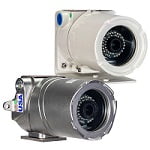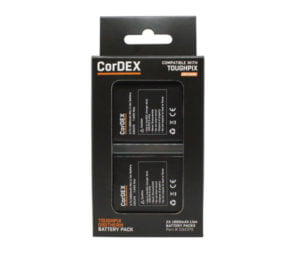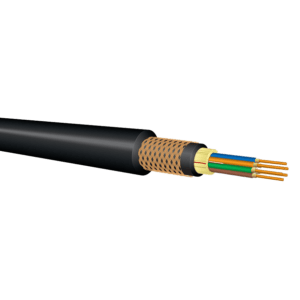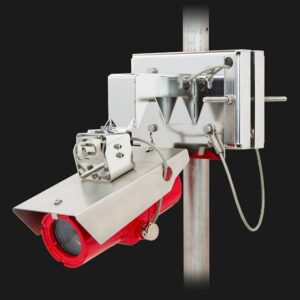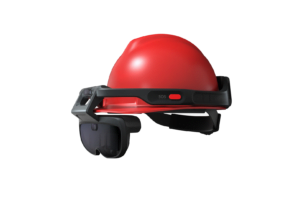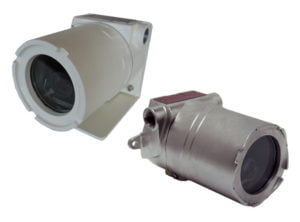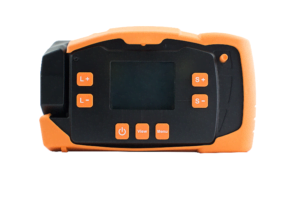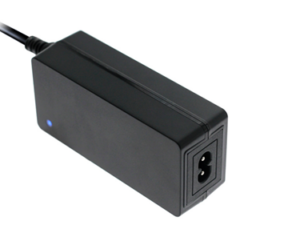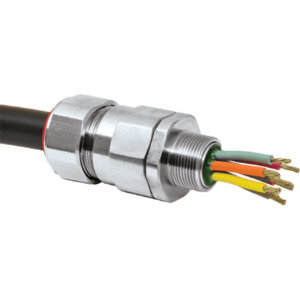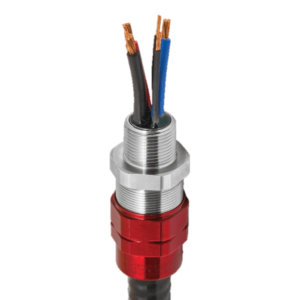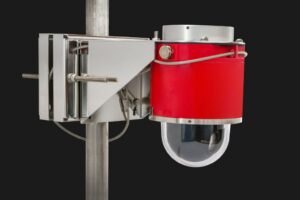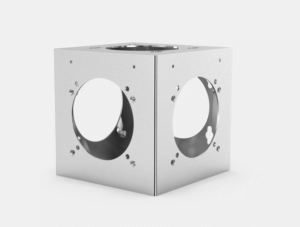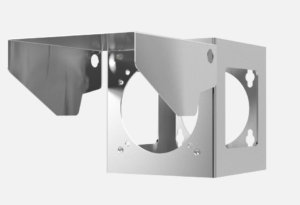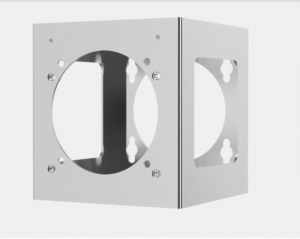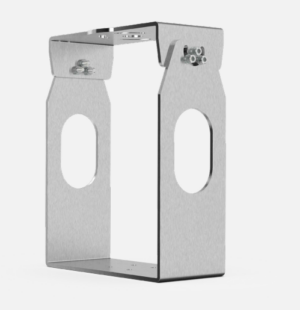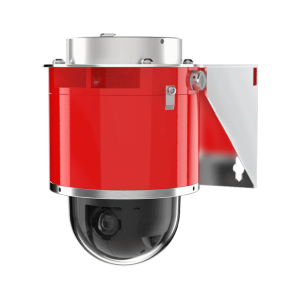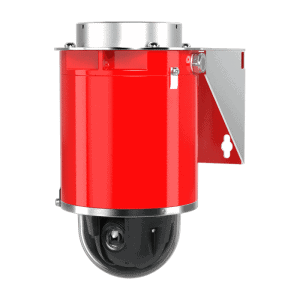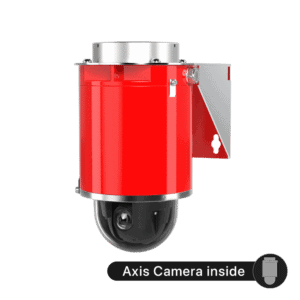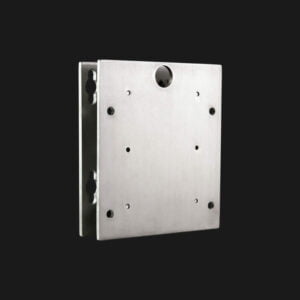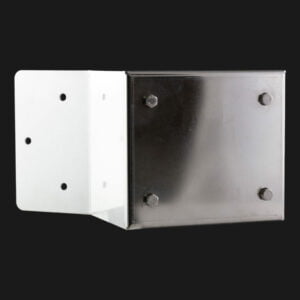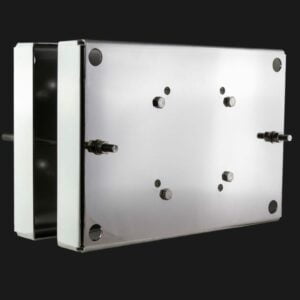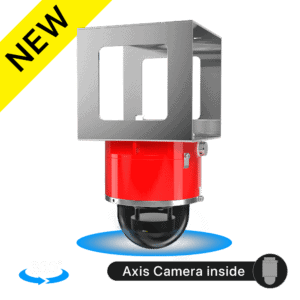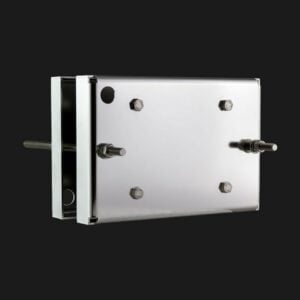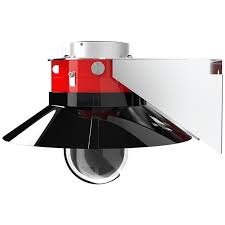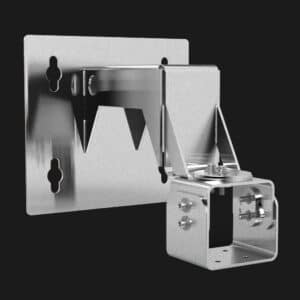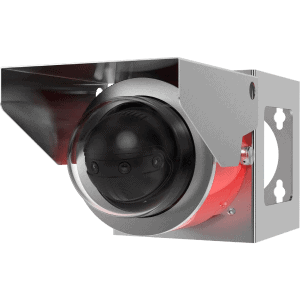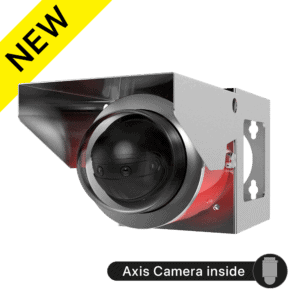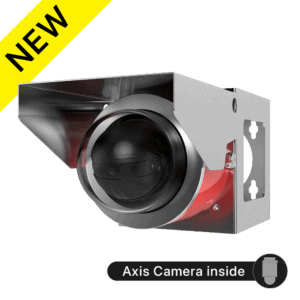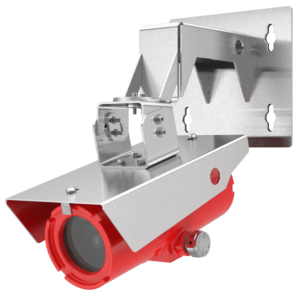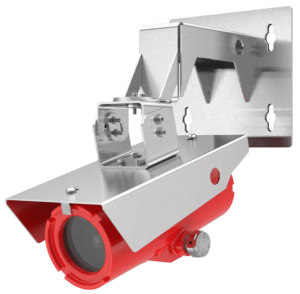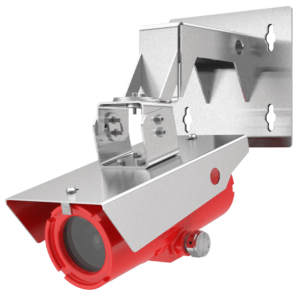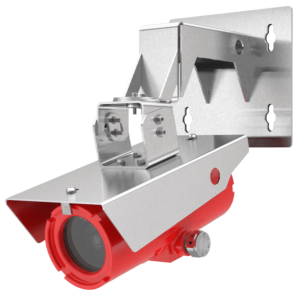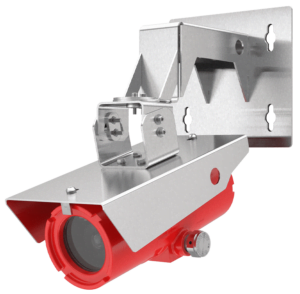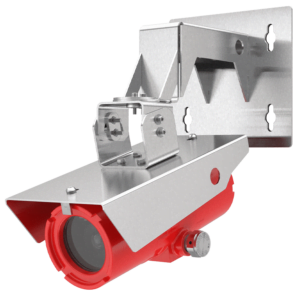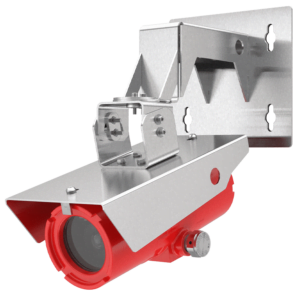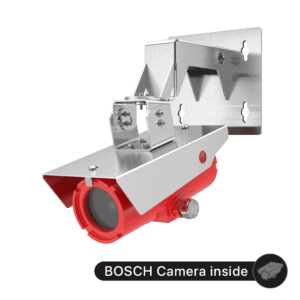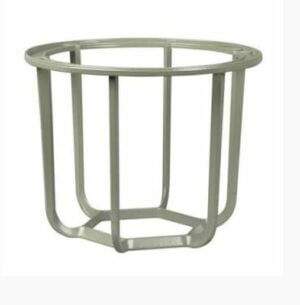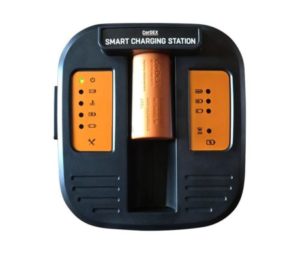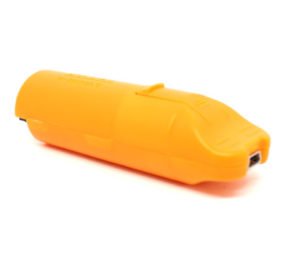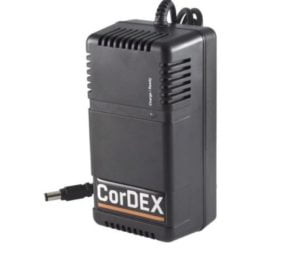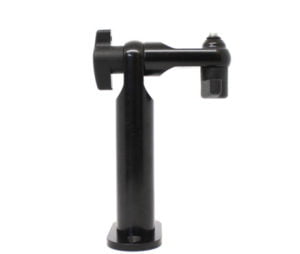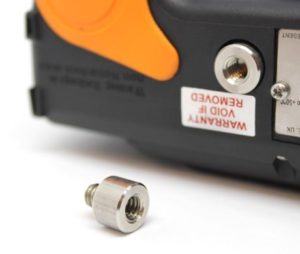Cameras
We provide intrinsically safe explosion proof cameras and housing from major manufacturers like Kaixuan, Cordex, Ecom, Dahua, and more. With atex rating certification and hazardous area categories including class 1 division 1 and class 1 division 2 for mining, chemical, oil, gas, and more. In hazardous areas, cameras that are fundamentally safe are required. As a precaution, electrical and electronic equipment operating in potentially explosive situations must have intrinsic safety features. This will safeguard them from external injury, external electrical or magnetic forces, and the isolation of cameras that are not fundamentally safe.
Show moreProtect yourself from technical disasters in dangerous areas by ensuring the intrinsic safety of your devices and other electrical equipment. By utilizing our intrinsically safe explosion proof cameras, no heat or spark strong enough to cause an explosion is generated.
Showing 1–48 of 52 results
-
%22%20transform%3D%22translate(.6%20.6)%20scale(1.22266)%22%20fill-opacity%3D%22.5%22%3E%3Cellipse%20fill%3D%22gray%22%20rx%3D%221%22%20ry%3D%221%22%20transform%3D%22matrix(-1.13695%20-63.2415%2046.89031%20-.843%20122%20118.6)%22%2F%3E%3Cellipse%20cx%3D%22244%22%20cy%3D%22120%22%20rx%3D%2283%22%20ry%3D%2283%22%2F%3E%3Cellipse%20rx%3D%221%22%20ry%3D%221%22%20transform%3D%22rotate(89.2%20-62.1%2068.3)%20scale(235.50338%2052.73092)%22%2F%3E%3Cellipse%20fill%3D%22%23747474%22%20rx%3D%221%22%20ry%3D%221%22%20transform%3D%22matrix(3.616%2036.87876%20-27.34448%202.68115%20123%20119.5)%22%2F%3E%3C%2Fg%3E%3C%2Fsvg%3E)
Bartec Pixavi Cam
$2,54584Price Depends on product optionMake a selection to update price -
%27%20fill-opacity%3D%27.5%27%3E%3Cellipse%20fill%3D%22%233a3a3a%22%20fill-opacity%3D%22.5%22%20rx%3D%221%22%20ry%3D%221%22%20transform%3D%22matrix(7.52945%2030.00891%20-45.42345%2011.39707%2066.9%20104.2)%22%2F%3E%3Cellipse%20fill%3D%22%23fff%22%20fill-opacity%3D%22.5%22%20rx%3D%221%22%20ry%3D%221%22%20transform%3D%22matrix(-25.96955%20-30.19238%20112.962%20-97.16265%2045.3%2011.2)%22%2F%3E%3Cellipse%20fill%3D%22%23fff%22%20fill-opacity%3D%22.5%22%20rx%3D%221%22%20ry%3D%221%22%20transform%3D%22matrix(-28.01487%2094.57886%20-39.09832%20-11.58117%20149.5%20136.1)%22%2F%3E%3Cellipse%20fill%3D%22%236c6c6c%22%20fill-opacity%3D%22.5%22%20rx%3D%221%22%20ry%3D%221%22%20transform%3D%22rotate(-46.5%20113.3%20-99.4)%20scale(31.37166%2021.40124)%22%2F%3E%3C%2Fg%3E%3C%2Fsvg%3E)
IVC AMZ-HD41-3 Explosion Proof CCTV Camera
$2,96609Price Depends on product optionMake a selection to update price -
%22%20transform%3D%22translate(.6%20.6)%20scale(1.17188)%22%20fill-opacity%3D%22.5%22%3E%3Cellipse%20fill%3D%22%23080808%22%20rx%3D%221%22%20ry%3D%221%22%20transform%3D%22matrix(50.58055%20-1.35034%202.45461%2091.94387%20122.7%20110.2)%22%2F%3E%3Cellipse%20fill%3D%22%23fff%22%20cx%3D%22228%22%20cy%3D%22110%22%20rx%3D%2245%22%20ry%3D%22255%22%2F%3E%3Cellipse%20fill%3D%22%23fff%22%20cx%3D%2226%22%20cy%3D%2298%22%20rx%3D%2236%22%20ry%3D%22255%22%2F%3E%3Cellipse%20fill%3D%22%23fff%22%20cx%3D%22227%22%20cy%3D%2292%22%20rx%3D%2232%22%20ry%3D%22255%22%2F%3E%3C%2Fg%3E%3C%2Fsvg%3E)
CorDEX ToughPix Digitherm – Rechargeable Battery Twin Pack
$25800 -
%27%20fill-opacity%3D%27.5%27%3E%3Cellipse%20fill-opacity%3D%22.5%22%20rx%3D%221%22%20ry%3D%221%22%20transform%3D%22matrix(46.38722%20-37.8325%2066.78333%2081.88445%20145.4%20118.7)%22%2F%3E%3Cellipse%20fill%3D%22%23fff%22%20fill-opacity%3D%22.5%22%20rx%3D%221%22%20ry%3D%221%22%20transform%3D%22matrix(-76.33438%20-288.91403%2062.13103%20-16.41573%20270.3%20110.2)%22%2F%3E%3Cellipse%20fill%3D%22%23fff%22%20fill-opacity%3D%22.5%22%20rx%3D%221%22%20ry%3D%221%22%20transform%3D%22matrix(-54.5633%2020.8357%20-106.60335%20-279.16658%2020.4%20158.2)%22%2F%3E%3Cpath%20fill%3D%22%23fff%22%20fill-opacity%3D%22.5%22%20d%3D%22M318.2%201.8L297%20271.3%20185.7-18.2z%22%2F%3E%3C%2Fg%3E%3C%2Fsvg%3E)
CorDEX ToughPix Digitherm Series – USB Card Reader
$14600 -
%22%20transform%3D%22translate(.6%20.6)%20scale(1.17188)%22%20fill-opacity%3D%22.5%22%3E%3Cellipse%20fill%3D%22%23888a73%22%20rx%3D%221%22%20ry%3D%221%22%20transform%3D%22matrix(107.69807%2021.32792%20-5.62912%2028.42496%20200%20135.9)%22%2F%3E%3Cellipse%20fill%3D%22%23404043%22%20rx%3D%221%22%20ry%3D%221%22%20transform%3D%22matrix(8.87028%20-30.13861%20153.53213%2045.18696%2015.4%20107.7)%22%2F%3E%3Cellipse%20fill%3D%22%23696871%22%20cx%3D%22166%22%20cy%3D%22118%22%20rx%3D%2232%22%20ry%3D%2230%22%2F%3E%3Cellipse%20cx%3D%2289%22%20cy%3D%22255%22%20rx%3D%22112%22%20ry%3D%22112%22%2F%3E%3C%2Fg%3E%3C%2Fsvg%3E)
Spectrum 190127 Cat6E cable
$1100 -
%27%20fill-opacity%3D%27.5%27%3E%3Cellipse%20fill%3D%22%23daced1%22%20fill-opacity%3D%22.5%22%20rx%3D%221%22%20ry%3D%221%22%20transform%3D%22matrix(83.15684%20-91.94878%2047.59115%2043.0406%20151.4%20135)%22%2F%3E%3Cpath%20fill-opacity%3D%22.5%22%20d%3D%22M164.6-15.8L-4-7.6l-14%20218z%22%2F%3E%3Cellipse%20fill%3D%22%23080c0a%22%20fill-opacity%3D%22.5%22%20rx%3D%221%22%20ry%3D%221%22%20transform%3D%22matrix(-32.27147%20-57.8464%20260.96462%20-145.58748%20220.6%20269)%22%2F%3E%3Cellipse%20fill-opacity%3D%22.5%22%20rx%3D%221%22%20ry%3D%221%22%20transform%3D%22matrix(156.93765%20116.55218%20-20.24782%2027.26371%2013.1%20266.6)%22%2F%3E%3C%2Fg%3E%3C%2Fsvg%3E)
Spectrum SF-RSK Reliable Securing Kit for Fixed Cameras
$67400 -
%27%20fill-opacity%3D%27.5%27%3E%3Cellipse%20fill%3D%22%23dc5160%22%20fill-opacity%3D%22.5%22%20rx%3D%221%22%20ry%3D%221%22%20transform%3D%22matrix(69.66118%20-5.16292%203.51405%2047.41367%20141.3%2069.6)%22%2F%3E%3Cellipse%20fill%3D%22%235f5461%22%20fill-opacity%3D%22.5%22%20rx%3D%221%22%20ry%3D%221%22%20transform%3D%22matrix(11.55936%20-39.91744%2035.13349%2010.17401%2096.2%20106.5)%22%2F%3E%3Cellipse%20fill-opacity%3D%22.5%22%20rx%3D%221%22%20ry%3D%221%22%20transform%3D%22matrix(59.30288%2041.82484%20-165.51535%20234.68205%20244.3%20160.6)%22%2F%3E%3Cellipse%20fill-opacity%3D%22.5%22%20rx%3D%221%22%20ry%3D%221%22%20transform%3D%22matrix(-46.06557%20-7.29607%2027.1818%20-171.6191%2019.9%2088.2)%22%2F%3E%3C%2Fg%3E%3C%2Fsvg%3E)
Rokid X-Craft AR Device
$7,21517Price Depends on product optionMake a selection to update price -
%27%20fill-opacity%3D%27.5%27%3E%3Cellipse%20fill%3D%22%237d7d7d%22%20fill-opacity%3D%22.5%22%20rx%3D%221%22%20ry%3D%221%22%20transform%3D%22matrix(-173.80695%20-74.49375%2016.76785%20-39.12232%20161.6%20117.2)%22%2F%3E%3Cellipse%20fill%3D%22%23fff%22%20fill-opacity%3D%22.5%22%20rx%3D%221%22%20ry%3D%221%22%20transform%3D%22matrix(120.73366%20-25.44257%2015.12008%2071.74991%20259.4%2027.3)%22%2F%3E%3Cellipse%20fill%3D%22%23fff%22%20fill-opacity%3D%22.5%22%20rx%3D%221%22%20ry%3D%221%22%20transform%3D%22matrix(-142.94186%20-47.55043%2016.76028%20-50.38326%2067.6%20191.4)%22%2F%3E%3Cellipse%20fill%3D%22%237e7e7e%22%20fill-opacity%3D%22.5%22%20rx%3D%221%22%20ry%3D%221%22%20transform%3D%22matrix(36.62045%20-42.81494%2023.21146%2019.85321%2070%2065.8)%22%2F%3E%3C%2Fg%3E%3C%2Fsvg%3E)
IVC AMZ-3041-2 X-Series Explosion Proof CCTV Camera
$2,75480Price Depends on product optionMake a selection to update price -
%27%20fill-opacity%3D%27.5%27%3E%3Cellipse%20fill%3D%22%23060606%22%20fill-opacity%3D%22.5%22%20rx%3D%221%22%20ry%3D%221%22%20transform%3D%22matrix(-.79368%20-56.83932%2095.74088%20-1.33688%20136.8%2089.3)%22%2F%3E%3Cpath%20fill%3D%22%23fff%22%20fill-opacity%3D%22.5%22%20d%3D%22M303.6%20243.5L5.2%20259-.1%20158.5l298.4-15.7z%22%2F%3E%3Cellipse%20fill%3D%22%23fff%22%20fill-opacity%3D%22.5%22%20rx%3D%221%22%20ry%3D%221%22%20transform%3D%22matrix(-34.45387%203.60344%20-31.08414%20-297.20704%20281.4%2081.5)%22%2F%3E%3Cellipse%20fill%3D%22%23fff%22%20fill-opacity%3D%22.5%22%20rx%3D%221%22%20ry%3D%221%22%20transform%3D%22rotate(-86.6%2029.5%2027.2)%20scale(298.82813%2037.75973)%22%2F%3E%3C%2Fg%3E%3C%2Fsvg%3E)
CorDEX TC7000 Camera
$10,76000 -
%27%20fill-opacity%3D%27.5%27%3E%3Cellipse%20fill%3D%22%230d0d0d%22%20fill-opacity%3D%22.5%22%20rx%3D%221%22%20ry%3D%221%22%20transform%3D%22matrix(-29.54812%2041.87689%20-84.24655%20-59.44393%20122.4%20112)%22%2F%3E%3Cellipse%20fill%3D%22%23fff%22%20fill-opacity%3D%22.5%22%20rx%3D%221%22%20ry%3D%221%22%20transform%3D%22matrix(-93.86756%20-232.85435%2081.70332%20-32.936%20280.3%2066.3)%22%2F%3E%3Cellipse%20fill%3D%22%23fff%22%20fill-opacity%3D%22.5%22%20rx%3D%221%22%20ry%3D%221%22%20transform%3D%22matrix(-235.02676%20-184.55533%2029.86688%20-38.03475%2055.7%20211.8)%22%2F%3E%3Cellipse%20fill%3D%22%23fff%22%20fill-opacity%3D%22.5%22%20rx%3D%221%22%20ry%3D%221%22%20transform%3D%22matrix(23.52116%20-47.38306%20267.66384%20132.86949%20262.3%2048)%22%2F%3E%3C%2Fg%3E%3C%2Fsvg%3E)
Merryking MKF-1205000C8 Adapter
$1050Price Depends on product optionMake a selection to update price -
%22%20transform%3D%22translate(.6%20.6)%20scale(1.17188)%22%20fill-opacity%3D%22.5%22%3E%3Cellipse%20fill%3D%22%23d8d9d4%22%20rx%3D%221%22%20ry%3D%221%22%20transform%3D%22matrix(7.17942%20-49.65613%20102.43468%2014.8103%20115.5%20121.8)%22%2F%3E%3Cellipse%20cx%3D%22125%22%20cy%3D%22231%22%20rx%3D%22255%22%20ry%3D%2246%22%2F%3E%3Cellipse%20rx%3D%221%22%20ry%3D%221%22%20transform%3D%22matrix(252.98925%2031.95997%20-5.8693%2046.46028%20130.6%2022.6)%22%2F%3E%3Cellipse%20fill%3D%22%23c6c5c9%22%20rx%3D%221%22%20ry%3D%221%22%20transform%3D%22matrix(-53.95063%203.33723%20-1.8718%20-30.26%20108%20118.4)%22%2F%3E%3C%2Fg%3E%3C%2Fsvg%3E)
Spectrum PX2KXREX Nickel Plated Brass Cable Gland
$10526Price Depends on product optionMake a selection to update price -
%27%20fill-opacity%3D%27.5%27%3E%3Cellipse%20fill%3D%22%23c28c9f%22%20fill-opacity%3D%22.5%22%20rx%3D%221%22%20ry%3D%221%22%20transform%3D%22rotate(93.9%20-20.2%20163)%20scale(109.29692%2060.60453)%22%2F%3E%3Cellipse%20fill%3D%22%23857977%22%20fill-opacity%3D%22.5%22%20rx%3D%221%22%20ry%3D%221%22%20transform%3D%22matrix(-30.20818%20-2.32865%2014.22074%20-184.47684%20143.7%2072.9)%22%2F%3E%3Cellipse%20fill-opacity%3D%22.5%22%20rx%3D%221%22%20ry%3D%221%22%20transform%3D%22rotate(174.9%20124.8%2060)%20scale(56.23817%20298.82811)%22%2F%3E%3Cellipse%20fill-opacity%3D%22.5%22%20rx%3D%221%22%20ry%3D%221%22%20transform%3D%22matrix(32.52898%20-297.05237%2055.90564%206.122%2040.5%20114.4)%22%2F%3E%3C%2Fg%3E%3C%2Fsvg%3E)
Spectrum TMC2X Hazardous Location Barrier Cable Gland
$17000Price Depends on product optionMake a selection to update price -
%27%20fill-opacity%3D%27.5%27%3E%3Cellipse%20fill%3D%22%23f7a741%22%20fill-opacity%3D%22.5%22%20rx%3D%221%22%20ry%3D%221%22%20transform%3D%22matrix(-27.86217%2069.54356%20-50.15492%20-20.09424%20137.8%20160.8)%22%2F%3E%3Cellipse%20fill%3D%22%23f8a13d%22%20fill-opacity%3D%22.5%22%20rx%3D%221%22%20ry%3D%221%22%20transform%3D%22matrix(5.40613%2038.84252%20-21.6339%203.01102%20135%2094.7)%22%2F%3E%3Cellipse%20fill%3D%22%23f89838%22%20fill-opacity%3D%22.5%22%20rx%3D%221%22%20ry%3D%221%22%20transform%3D%22rotate(-89.1%20170.6%20-14.3)%20scale(23.13714%2041.70231)%22%2F%3E%3Cpath%20fill%3D%22%23ff490a%22%20fill-opacity%3D%22.5%22%20d%3D%22M.6-18.2l2.3%20336.4%20113.7-211z%22%2F%3E%3C%2Fg%3E%3C%2Fsvg%3E)
Spectrum 258802404 ITC-HL Cable
$3500 -
%27%20fill-opacity%3D%27.5%27%3E%3Cpath%20fill-opacity%3D%22.5%22%20d%3D%22M135.5%208.2L69.9%209.4%2069.6-7l65.6-1.2z%22%2F%3E%3Cellipse%20fill%3D%22%23bcbcbc%22%20fill-opacity%3D%22.5%22%20rx%3D%221%22%20ry%3D%221%22%20transform%3D%22matrix(9.74146%2017.35908%20-55.998%2031.42461%2012.5%2028.7)%22%2F%3E%3Cpath%20fill-opacity%3D%22.5%22%20d%3D%22M279%20.2l24.7.8-.4%209.4-24.5-.9zM70.9.6H133v8.2H71z%22%2F%3E%3C%2Fg%3E%3C%2Fsvg%3E)
Spectrum SCS-CBL-D1 Easy Install Kit
$1,12200Price Depends on product optionMake a selection to update price -
%27%20fill-opacity%3D%27.5%27%3E%3Cellipse%20fill%3D%22%23be858d%22%20fill-opacity%3D%22.5%22%20rx%3D%221%22%20ry%3D%221%22%20transform%3D%22matrix(7.01603%2053.35473%20-89.5578%2011.77666%20122.9%2071.3)%22%2F%3E%3Cellipse%20fill%3D%22%23b81631%22%20fill-opacity%3D%22.5%22%20rx%3D%221%22%20ry%3D%221%22%20transform%3D%22matrix(48.82006%207.38334%20-8.90378%2058.87351%20200.8%2077.8)%22%2F%3E%3Cellipse%20fill%3D%22%23000505%22%20fill-opacity%3D%22.5%22%20rx%3D%221%22%20ry%3D%221%22%20transform%3D%22matrix(39.11545%20-293.15668%2037.63828%205.02202%20282.4%2085.8)%22%2F%3E%3Cellipse%20fill%3D%22%230c1e1a%22%20fill-opacity%3D%22.5%22%20rx%3D%221%22%20ry%3D%221%22%20transform%3D%22matrix(-295.46822%20-44.68537%205.88375%20-38.9045%20.5%20163)%22%2F%3E%3C%2Fg%3E%3C%2Fsvg%3E)
Spectrum SD-RSK Reliable Securing Kit for Dome Cameras
$67400 -
%22%20transform%3D%22translate(.6%20.6)%20scale(1.17188)%22%20fill-opacity%3D%22.5%22%3E%3Cellipse%20fill%3D%22%23a9a9a9%22%20rx%3D%221%22%20ry%3D%221%22%20transform%3D%22matrix(1.04277%20-41.13944%2057.06305%201.44639%20114.5%20120.4)%22%2F%3E%3Cellipse%20fill%3D%22%23fff%22%20rx%3D%221%22%20ry%3D%221%22%20transform%3D%22matrix(-25.68952%20-7.51691%206.22311%20-21.26789%20249.7%200)%22%2F%3E%3Cellipse%20fill%3D%22%23e5e5e5%22%20rx%3D%221%22%20ry%3D%221%22%20transform%3D%22matrix(152.2138%20-10.299%202.7248%2040.27126%2085.2%2031.3)%22%2F%3E%3Cellipse%20fill%3D%22%23e6e6e6%22%20cx%3D%22101%22%20cy%3D%22185%22%20rx%3D%22255%22%20ry%3D%2230%22%2F%3E%3C%2Fg%3E%3C%2Fsvg%3E)
Spectrum SCS-MM Multi-mount for Explosion-Proof Cameras
$1,17000 -
%22%20transform%3D%22translate(.6%20.6)%20scale(1.17188)%22%20fill-opacity%3D%22.5%22%3E%3Cellipse%20fill%3D%22%237b7b7b%22%20cx%3D%2273%22%20cy%3D%2254%22%20rx%3D%2261%22%20ry%3D%2229%22%2F%3E%3Cellipse%20fill%3D%22%23fff%22%20rx%3D%221%22%20ry%3D%221%22%20transform%3D%22matrix(-130.86412%20-65.9146%2023.94192%20-47.5333%2087.5%20173)%22%2F%3E%3Cellipse%20fill%3D%22%23b1b1b1%22%20cx%3D%22164%22%20cy%3D%2289%22%20rx%3D%2255%22%20ry%3D%2255%22%2F%3E%3Cellipse%20fill%3D%22%23fff%22%20rx%3D%221%22%20ry%3D%221%22%20transform%3D%22matrix(53.85271%2021.66874%20-12.29205%2030.5491%2030.4%20159.1)%22%2F%3E%3C%2Fg%3E%3C%2Fsvg%3E)
Spectrum SD-UM-SS-D1XX Universal Mount with Sunshield
$1,17000 -
%22%20transform%3D%22translate(.6%20.6)%20scale(1.17188)%22%20fill-opacity%3D%22.5%22%3E%3Cellipse%20fill%3D%22%23a3a3a3%22%20rx%3D%221%22%20ry%3D%221%22%20transform%3D%22matrix(13.7506%2072.773%20-50.32326%209.50868%20101.8%2092.6)%22%2F%3E%3Cellipse%20fill%3D%22%23eaeaea%22%20cx%3D%22213%22%20cy%3D%2242%22%20rx%3D%2252%22%20ry%3D%22255%22%2F%3E%3Cellipse%20fill%3D%22%23898989%22%20rx%3D%221%22%20ry%3D%221%22%20transform%3D%22matrix(-5.88408%20-36.73554%2013.01192%20-2.08417%2094.9%20100.3)%22%2F%3E%3Cpath%20fill%3D%22%23ebebeb%22%20d%3D%22M49.7-29l-4.4%20251-61-1%204.4-251z%22%2F%3E%3C%2Fg%3E%3C%2Fsvg%3E)
Spectrum SCS-UM Universal mount for Camera
$1,12200 -
%27%20fill-opacity%3D%27.5%27%3E%3Cellipse%20fill%3D%22%23fff%22%20fill-opacity%3D%22.5%22%20rx%3D%221%22%20ry%3D%221%22%20transform%3D%22matrix(5.20089%20297.95877%20-22.62568%20.39493%20287.1%20163.6)%22%2F%3E%3Cellipse%20fill%3D%22%23a8a8a8%22%20fill-opacity%3D%22.5%22%20rx%3D%221%22%20ry%3D%221%22%20transform%3D%22matrix(24.74567%20-29.53228%2021.51462%2018.02751%20174%20237.7)%22%2F%3E%3Cellipse%20fill%3D%22%23aaa%22%20fill-opacity%3D%22.5%22%20rx%3D%221%22%20ry%3D%221%22%20transform%3D%22matrix(17.54033%2028.32507%20-22.1721%2013.7301%20177.8%2061.6)%22%2F%3E%3Cellipse%20fill%3D%22%23a4a4a4%22%20fill-opacity%3D%22.5%22%20rx%3D%221%22%20ry%3D%221%22%20transform%3D%22rotate(-45.9%20324%2019.4)%20scale(21.15217%2033.47138)%22%2F%3E%3C%2Fg%3E%3C%2Fsvg%3E)
Spectrum SF-CM-PM Fixed Ceiling Mount for Camera
$95400 -
%22%20transform%3D%22translate(.6%20.6)%20scale(1.17188)%22%20fill-opacity%3D%22.5%22%3E%3Cellipse%20fill%3D%22%23ff7c78%22%20rx%3D%221%22%20ry%3D%221%22%20transform%3D%22matrix(-7.11724%2078.20534%20-101.79883%20-9.26442%20127%20100.3)%22%2F%3E%3Cellipse%20rx%3D%221%22%20ry%3D%221%22%20transform%3D%22matrix(-7.01898%20-41.86077%20251.48923%20-42.16831%20164.4%20230.6)%22%2F%3E%3Cpath%20d%3D%22M270-16L-2-1l264%2056z%22%2F%3E%3Cellipse%20cx%3D%228%22%20cy%3D%22176%22%20rx%3D%2228%22%20ry%3D%22255%22%2F%3E%3C%2Fg%3E%3C%2Fsvg%3E)
Spectrum D401-X-P5655-E-BD Explosion-Proof PTZ Camera
$17,97600Price Depends on product optionMake a selection to update price -
%27%20fill-opacity%3D%27.5%27%3E%3Cellipse%20fill%3D%22%23ff7775%22%20fill-opacity%3D%22.5%22%20rx%3D%221%22%20ry%3D%221%22%20transform%3D%22matrix(22.97976%20115.75758%20-104.1443%2020.67433%20144.3%2093)%22%2F%3E%3Cellipse%20fill-opacity%3D%22.5%22%20rx%3D%221%22%20ry%3D%221%22%20transform%3D%22matrix(134.7349%20-266.72975%2053.26984%2026.90853%20279.7%20206.1)%22%2F%3E%3Cellipse%20fill-opacity%3D%22.5%22%20rx%3D%221%22%20ry%3D%221%22%20transform%3D%22matrix(31.23605%20297.19112%20-30.62716%203.21904%2023.8%20227.6)%22%2F%3E%3Cellipse%20fill%3D%22%23ff1405%22%20fill-opacity%3D%22.5%22%20rx%3D%221%22%20ry%3D%221%22%20transform%3D%22matrix(-81.41562%205.08562%20-4.48715%20-71.83473%20133%20138.5)%22%2F%3E%3C%2Fg%3E%3C%2Fsvg%3E)
Spectrum D201-X-Q6078-BD Explosion-Proof 4K PTZ Camera
$22,24600Price Depends on product optionMake a selection to update price -
%22%20transform%3D%22translate(.6%20.6)%20scale(1.17188)%22%20fill-opacity%3D%22.5%22%3E%3Cellipse%20fill%3D%22%23ff615e%22%20rx%3D%221%22%20ry%3D%221%22%20transform%3D%22matrix(-74.0252%20-3.4538%203.79911%20-81.42631%20119.2%20101)%22%2F%3E%3Cellipse%20rx%3D%221%22%20ry%3D%221%22%20transform%3D%22matrix(-35.34247%203.4031%20-24.44067%20-253.82604%2020.1%20135.8)%22%2F%3E%3Cellipse%20cx%3D%22235%22%20cy%3D%2267%22%20rx%3D%2238%22%20ry%3D%22145%22%2F%3E%3Cellipse%20fill%3D%22%23ff311c%22%20rx%3D%221%22%20ry%3D%221%22%20transform%3D%22rotate(-151.8%2071.5%2038.8)%20scale(63.477%2052.9841)%22%2F%3E%3C%2Fg%3E%3C%2Fsvg%3E)
Spectrum D201-X-Q6075-E-BD Explosion-Proof PTZ Camera
$21,34800Price Depends on product optionMake a selection to update price -
%22%20transform%3D%22translate(.6%20.6)%20scale(1.17188)%22%20fill-opacity%3D%22.5%22%3E%3Cellipse%20fill%3D%22%23fff%22%20rx%3D%221%22%20ry%3D%221%22%20transform%3D%22rotate(93.8%209%20120.6)%20scale(73.88966%2058.7949)%22%2F%3E%3Cellipse%20cx%3D%2222%22%20cy%3D%22167%22%20rx%3D%2239%22%20ry%3D%22254%22%2F%3E%3Cellipse%20rx%3D%221%22%20ry%3D%221%22%20transform%3D%22matrix(-36.33139%20-.95137%205.73785%20-219.1198%20232.9%20162.2)%22%2F%3E%3Cellipse%20fill%3D%22%23ededed%22%20rx%3D%221%22%20ry%3D%221%22%20transform%3D%22matrix(36.05826%20-2.40177%203.23483%2048.56511%20132.1%20114.7)%22%2F%3E%3C%2Fg%3E%3C%2Fsvg%3E)
Spectrum SCS-VM Vibration Mount for Camera
$1,17800 -
%27%20fill-opacity%3D%27.5%27%3E%3Cellipse%20fill%3D%22%23fff%22%20fill-opacity%3D%22.5%22%20rx%3D%221%22%20ry%3D%221%22%20transform%3D%22rotate(-123.7%2069.6%2051.1)%20scale(76.83775%2067.79573)%22%2F%3E%3Cellipse%20fill-opacity%3D%22.5%22%20rx%3D%221%22%20ry%3D%221%22%20transform%3D%22matrix(-298.76497%20-6.14326%20.98496%20-47.90133%20203.3%20274.1)%22%2F%3E%3Cellipse%20fill-opacity%3D%22.5%22%20rx%3D%221%22%20ry%3D%221%22%20transform%3D%22matrix(1.56213%20-34.80897%20219.71446%209.86015%20168.3%2023)%22%2F%3E%3Cellipse%20fill%3D%22%23b4b4b4%22%20fill-opacity%3D%22.5%22%20rx%3D%221%22%20ry%3D%221%22%20transform%3D%22rotate(-149.6%20143.4%2037.4)%20scale(53.43346%2062.94053)%22%2F%3E%3C%2Fg%3E%3C%2Fsvg%3E)
Spectrum SCS-CM Corner Mount for Camera
$1,17800 -
%27%20fill-opacity%3D%27.5%27%3E%3Cellipse%20fill%3D%22%23fff%22%20fill-opacity%3D%22.5%22%20rx%3D%221%22%20ry%3D%221%22%20transform%3D%22matrix(-4.0085%20-81.95963%20107.8602%20-5.27524%20173.8%20128.7)%22%2F%3E%3Cellipse%20fill-opacity%3D%22.5%22%20rx%3D%221%22%20ry%3D%221%22%20transform%3D%22matrix(1.38192%2043.84233%20-298.67979%209.41447%20153.3%20269.3)%22%2F%3E%3Cellipse%20fill%3D%22%23020202%22%20fill-opacity%3D%22.5%22%20rx%3D%221%22%20ry%3D%221%22%20transform%3D%22matrix(-298.3555%2016.80006%20-1.35003%20-23.97542%20147.4%208.6)%22%2F%3E%3Cellipse%20fill%3D%22%23fcfcfc%22%20fill-opacity%3D%22.5%22%20rx%3D%221%22%20ry%3D%221%22%20transform%3D%22matrix(-12.68324%2045.83264%20-58.94246%20-16.31111%20192.9%20117.4)%22%2F%3E%3C%2Fg%3E%3C%2Fsvg%3E)
Spectrum SCS-PM XL Pole Mount for D-&-F-Series Camera
$1,40400 -
%22%20transform%3D%22translate(.6%20.6)%20scale(1.17188)%22%20fill-opacity%3D%22.5%22%3E%3Cellipse%20fill%3D%22%23fff28d%22%20rx%3D%221%22%20ry%3D%221%22%20transform%3D%22rotate(39.2%20-1.2%20101.4)%20scale(124.48786%2071.81924)%22%2F%3E%3Cellipse%20rx%3D%221%22%20ry%3D%221%22%20transform%3D%22matrix(-53.27706%20-4.00592%2010.84926%20-144.29053%20239%2092.6)%22%2F%3E%3Cellipse%20fill%3D%22%2310a6ff%22%20rx%3D%221%22%20ry%3D%221%22%20transform%3D%22matrix(27.98856%2038.81893%20-54.24099%2039.10791%2043%20238.3)%22%2F%3E%3Cellipse%20cx%3D%228%22%20cy%3D%22151%22%20rx%3D%2258%22%20ry%3D%2250%22%2F%3E%3C%2Fg%3E%3C%2Fsvg%3E)
Spectrum D101-X-M4328-P-BD Explosion-Proof Fisheye Camera
$13,35492Price Depends on product optionMake a selection to update price -
%22%20transform%3D%22translate(.6%20.6)%20scale(1.17188)%22%20fill-opacity%3D%22.5%22%3E%3Cellipse%20fill%3D%22%23fff%22%20rx%3D%221%22%20ry%3D%221%22%20transform%3D%22matrix(74.9092%20-7.15328%205.55737%2058.19682%20143.8%20119)%22%2F%3E%3Cellipse%20cx%3D%22129%22%20cy%3D%22237%22%20rx%3D%22255%22%20ry%3D%2247%22%2F%3E%3Cellipse%20rx%3D%221%22%20ry%3D%221%22%20transform%3D%22matrix(-254.69663%2012.43495%20-1.53127%20-31.36398%20127.8%2017)%22%2F%3E%3Cellipse%20fill%3D%22%23e8e8e8%22%20cx%3D%22150%22%20cy%3D%22116%22%20rx%3D%2248%22%20ry%3D%2235%22%2F%3E%3C%2Fg%3E%3C%2Fsvg%3E)
Spectrum SCS-PM Pole mount
$1,06600 -
%22%20transform%3D%22translate(.5%20.5)%22%20fill-opacity%3D%22.5%22%3E%3Cellipse%20fill%3D%22%230e0000%22%20rx%3D%221%22%20ry%3D%221%22%20transform%3D%22matrix(-1.822%2050.40997%20-58.99446%20-2.13227%2097.5%20115)%22%2F%3E%3Cellipse%20fill%3D%22%23fff%22%20cx%3D%22153%22%20cy%3D%22207%22%20rx%3D%22224%22%20ry%3D%2240%22%2F%3E%3Cellipse%20fill%3D%22%23fff%22%20rx%3D%221%22%20ry%3D%221%22%20transform%3D%22rotate(-178.6%2058.6%205.7)%20scale(224%2044.62948)%22%2F%3E%3Cellipse%20fill%3D%22%231c0f16%22%20cx%3D%2292%22%20cy%3D%22116%22%20rx%3D%2236%22%20ry%3D%2229%22%2F%3E%3C%2Fg%3E%3C%2Fsvg%3E)
Spectrum SD-WM Wall-Mount for D-Series Fixed Cameras
$95400 -
%27%20fill-opacity%3D%27.5%27%3E%3Cellipse%20fill%3D%22silver%22%20fill-opacity%3D%22.5%22%20rx%3D%221%22%20ry%3D%221%22%20transform%3D%22rotate(-120.2%20107.7%2022.8)%20scale(101.59955%2077.15327)%22%2F%3E%3Cellipse%20fill-opacity%3D%22.5%22%20rx%3D%221%22%20ry%3D%221%22%20transform%3D%22matrix(138.5505%2034.7373%20-14.28135%2056.9615%2051.1%20273.9)%22%2F%3E%3Cellipse%20fill-opacity%3D%22.5%22%20rx%3D%221%22%20ry%3D%221%22%20transform%3D%22matrix(138.4743%20255.03479%20-48.2706%2026.20912%20281.3%2071.1)%22%2F%3E%3Cellipse%20fill-opacity%3D%22.5%22%20rx%3D%221%22%20ry%3D%221%22%20transform%3D%22matrix(4.47666%2034.33682%20-56.01052%207.30237%20280.2%20298.6)%22%2F%3E%3C%2Fg%3E%3C%2Fsvg%3E)
Spectrum F1XX-WM Wall-Mount for F Series Fixed Cameras
$95400 -
%27%20fill-opacity%3D%27.5%27%3E%3Cpath%20fill%3D%22%23dbced2%22%20fill-opacity%3D%22.5%22%20d%3D%22M319.6%20240.2l-127.3%2011.1-16.2-185.6%20127.3-11.1z%22%2F%3E%3Cellipse%20fill-opacity%3D%22.5%22%20rx%3D%221%22%20ry%3D%221%22%20transform%3D%22rotate(19.9%20-735.8%20412.3)%20scale(298.82813%2056.05055)%22%2F%3E%3Cellipse%20fill-opacity%3D%22.5%22%20rx%3D%221%22%20ry%3D%221%22%20transform%3D%22matrix(298.54371%20-13.0347%201.365%2031.26352%20133.8%2015)%22%2F%3E%3Cellipse%20fill%3D%22%23898d8c%22%20fill-opacity%3D%22.5%22%20rx%3D%221%22%20ry%3D%221%22%20transform%3D%22rotate(-51.6%20162.8%20-147)%20scale(48.21142%2070.61476)%22%2F%3E%3C%2Fg%3E%3C%2Fsvg%3E)
Spectrum D101-X-P3827-PVE-BD Explosion-Proof Camera
$14,00000Price Depends on product optionMake a selection to update price -
%27%20fill-opacity%3D%27.5%27%3E%3Cellipse%20fill%3D%22%23cdcddd%22%20fill-opacity%3D%22.5%22%20rx%3D%221%22%20ry%3D%221%22%20transform%3D%22matrix(69.74683%2057.07212%20-38.46264%2047.00452%20244.7%20137)%22%2F%3E%3Cellipse%20fill%3D%22%23ff0%22%20fill-opacity%3D%22.5%22%20rx%3D%221%22%20ry%3D%221%22%20transform%3D%22matrix(34.83505%2043.9509%20-96.76356%2076.69386%2012.7%2038.1)%22%2F%3E%3Cellipse%20fill-opacity%3D%22.5%22%20rx%3D%221%22%20ry%3D%221%22%20transform%3D%22matrix(-47.20426%2020.525%20-40.68728%20-93.57434%2036.5%20256.4)%22%2F%3E%3Cellipse%20fill-opacity%3D%22.5%22%20rx%3D%221%22%20ry%3D%221%22%20transform%3D%22rotate(-170.8%20122.8%20.9)%20scale(145.86078%2050.17616)%22%2F%3E%3C%2Fg%3E%3C%2Fsvg%3E)
Spectrum D101-X-Q3819-BD Explosion-Proof Panoramic Camera
$15,50000Price Depends on product optionMake a selection to update price -
%27%20fill-opacity%3D%27.5%27%3E%3Cellipse%20fill%3D%22%23cecbdd%22%20fill-opacity%3D%22.5%22%20rx%3D%221%22%20ry%3D%221%22%20transform%3D%22matrix(-58.85537%2032.62407%20-37.75844%20-68.11803%20244.1%20147.5)%22%2F%3E%3Cellipse%20fill%3D%22%23ff0%22%20fill-opacity%3D%22.5%22%20rx%3D%221%22%20ry%3D%221%22%20transform%3D%22matrix(-70.45296%2061.6769%20-33.03847%20-37.73954%2031.6%2030)%22%2F%3E%3Cellipse%20fill-opacity%3D%22.5%22%20rx%3D%221%22%20ry%3D%221%22%20transform%3D%22rotate(67.8%20-179.6%20161)%20scale(115.07794%2057.10978)%22%2F%3E%3Cellipse%20fill-opacity%3D%22.5%22%20rx%3D%221%22%20ry%3D%221%22%20transform%3D%22matrix(-5.3018%2037.00917%20-147.2076%20-21.08843%20249.1%2031)%22%2F%3E%3C%2Fg%3E%3C%2Fsvg%3E)
Spectrum D101-X-P3818-BD Explosion-Proof Panoramic Camera
$15,10000Price Depends on product optionMake a selection to update price -
%27%20fill-opacity%3D%27.5%27%3E%3Cpath%20fill%3D%22%23f2f0f2%22%20fill-opacity%3D%22.5%22%20d%3D%22M318.2%208.8l-194.6-27-9.3%20328.2z%22%2F%3E%3Cellipse%20fill-opacity%3D%22.5%22%20rx%3D%221%22%20ry%3D%221%22%20transform%3D%22matrix(46.41246%20-91.15566%2057.9247%2029.49271%2035%2067.2)%22%2F%3E%3Cpath%20fill-opacity%3D%22.5%22%20d%3D%22M318.2%20300.6V129.5L130.7%20308.8z%22%2F%3E%3Cellipse%20fill-opacity%3D%22.5%22%20rx%3D%221%22%20ry%3D%221%22%20transform%3D%22rotate(-65.9%2064.7%205.3)%20scale(101.22127%2059.32709)%22%2F%3E%3C%2Fg%3E%3C%2Fsvg%3E)
Spectrum F101-Q1715-BD Explosion-Proof Fixed Camera
$7,30000 -
%27%20fill-opacity%3D%27.5%27%3E%3Cellipse%20fill-opacity%3D%22.5%22%20rx%3D%221%22%20ry%3D%221%22%20transform%3D%22matrix(-38.12996%20100.81059%20-67.54252%20-25.54686%2032%2058.2)%22%2F%3E%3Cellipse%20fill%3D%22%23edf1f1%22%20fill-opacity%3D%22.5%22%20rx%3D%221%22%20ry%3D%221%22%20transform%3D%22matrix(88.6189%20-175.56683%2075.23658%2037.97632%20215.4%2053.5)%22%2F%3E%3Cellipse%20fill-opacity%3D%22.5%22%20rx%3D%221%22%20ry%3D%221%22%20transform%3D%22matrix(-36.51552%20-38.6204%20217.13775%20-205.3033%20260%20257.4)%22%2F%3E%3Cellipse%20fill-opacity%3D%22.5%22%20rx%3D%221%22%20ry%3D%221%22%20transform%3D%22matrix(-55.69018%20-19.25395%2036.7605%20-106.32615%2036.9%2050.9)%22%2F%3E%3C%2Fg%3E%3C%2Fsvg%3E)
Spectrum F101-Q1656-BD Explosion-Proof Network Camera
$7,20000 -
%27%20fill-opacity%3D%27.5%27%3E%3Cpath%20fill%3D%22%23f2f0f2%22%20fill-opacity%3D%22.5%22%20d%3D%22M124.8-18.2l-10.5%20329.3L318.2%208.8z%22%2F%3E%3Cellipse%20fill-opacity%3D%22.5%22%20rx%3D%221%22%20ry%3D%221%22%20transform%3D%22matrix(58.81397%2028.82306%20-46.37532%2094.62968%2036%2065.9)%22%2F%3E%3Cellipse%20fill-opacity%3D%22.5%22%20rx%3D%221%22%20ry%3D%221%22%20transform%3D%22matrix(-194.66511%20179.28719%20-40.52358%20-43.99939%20264.5%20261.5)%22%2F%3E%3Cellipse%20fill-opacity%3D%22.5%22%20rx%3D%221%22%20ry%3D%221%22%20transform%3D%22matrix(60.8098%20-95.45228%2062.30168%2039.69055%2015.6%2065.3)%22%2F%3E%3C%2Fg%3E%3C%2Fsvg%3E)
Spectrum F110-XXCH5ABX-BD Explosion-Proof fixed Camera
$6,90000Price Depends on product optionMake a selection to update price -
%22%20transform%3D%22translate(.6%20.6)%20scale(1.17188)%22%20fill-opacity%3D%22.5%22%3E%3Cellipse%20rx%3D%221%22%20ry%3D%221%22%20transform%3D%22matrix(-50.0138%20-37.98772%2058.57028%20-77.11233%2017.2%2060.7)%22%2F%3E%3Cellipse%20fill%3D%22%23e5efed%22%20cx%3D%22175%22%20cy%3D%2241%22%20rx%3D%2280%22%20ry%3D%22134%22%2F%3E%3Cpath%20d%3D%22M135.8%20245L228%20123l90.3%2068L226%20313.1z%22%2F%3E%3Cellipse%20fill%3D%22%23d8a2b5%22%20rx%3D%221%22%20ry%3D%221%22%20transform%3D%22matrix(-81.4476%20-10.86743%207.65297%20-57.35636%20121.9%20164.5)%22%2F%3E%3C%2Fg%3E%3C%2Fsvg%3E)
Spectrum F101-P1378-BD Explosion-Proof 4K fixed Camera
$7,07800Price Depends on product optionMake a selection to update price -
%22%20transform%3D%22translate(.6%20.6)%20scale(1.17188)%22%20fill-opacity%3D%22.5%22%3E%3Cellipse%20rx%3D%221%22%20ry%3D%221%22%20transform%3D%22rotate(-51.1%2061.6%2020.3)%20scale(100.24878%2074.6696)%22%2F%3E%3Cellipse%20fill%3D%22%23e1f0ec%22%20cx%3D%22179%22%20cy%3D%2268%22%20rx%3D%2290%22%20ry%3D%2290%22%2F%3E%3Cellipse%20rx%3D%221%22%20ry%3D%221%22%20transform%3D%22matrix(-184.2613%20176.2747%20-31.62729%20-33.06025%20212%20228.7)%22%2F%3E%3Cellipse%20fill%3D%22%23e0b2c3%22%20rx%3D%221%22%20ry%3D%221%22%20transform%3D%22matrix(1.37998%20-52.87742%2073.89721%201.92856%20116.1%20160.8)%22%2F%3E%3C%2Fg%3E%3C%2Fsvg%3E)
Spectrum F101-P1377-BD Explosion-Proof 5MP fixed Camera
$6,40400Price Depends on product optionMake a selection to update price -
%22%20transform%3D%22translate(.6%20.6)%20scale(1.17188)%22%20fill-opacity%3D%22.5%22%3E%3Cellipse%20rx%3D%221%22%20ry%3D%221%22%20transform%3D%22matrix(-32.11968%2087.75749%20-52.5332%20-19.2274%2032.6%2047.6)%22%2F%3E%3Cellipse%20fill%3D%22%23e5f5f1%22%20cx%3D%22182%22%20cy%3D%2263%22%20rx%3D%2288%22%20ry%3D%2288%22%2F%3E%3Cellipse%20rx%3D%221%22%20ry%3D%221%22%20transform%3D%22matrix(-159.47187%20155.74703%20-38.23193%20-39.14628%20220%20232.8)%22%2F%3E%3Cellipse%20fill%3D%22%23e2bbc9%22%20rx%3D%221%22%20ry%3D%221%22%20transform%3D%22matrix(-76.29086%205.34616%20-3.5178%20-50.19978%20116%20157.2)%22%2F%3E%3C%2Fg%3E%3C%2Fsvg%3E)
Spectrum F101-P1375-BD Explosion-Proof 2MP fixed Camera
$6,06600Price Depends on product optionMake a selection to update price -
%22%20transform%3D%22translate(.6%20.6)%20scale(1.17188)%22%20fill-opacity%3D%22.5%22%3E%3Cellipse%20rx%3D%221%22%20ry%3D%221%22%20transform%3D%22rotate(-59.1%2063.7%207.1)%20scale(89.45719%2060.22469)%22%2F%3E%3Cellipse%20fill%3D%22%23e3eeec%22%20cx%3D%22175%22%20cy%3D%2255%22%20rx%3D%2281%22%20ry%3D%22118%22%2F%3E%3Cellipse%20rx%3D%221%22%20ry%3D%221%22%20transform%3D%22matrix(-165.4766%20167.2186%20-34.25285%20-33.89602%20200%20243)%22%2F%3E%3Cellipse%20rx%3D%221%22%20ry%3D%221%22%20transform%3D%22matrix(-63.67865%2079.58422%20-59.40827%20-47.53504%200%2050.6)%22%2F%3E%3C%2Fg%3E%3C%2Fsvg%3E)
Spectrum F112-NBN80052BA-BD ExplosionProof Network Camera
$7,41400 -
%27%20fill-opacity%3D%27.5%27%3E%3Cellipse%20fill%3D%22%23f6dde6%22%20fill-opacity%3D%22.5%22%20rx%3D%221%22%20ry%3D%221%22%20transform%3D%22matrix(-59.00673%20-33.93773%2064.2626%20-111.73184%20174%20121.5)%22%2F%3E%3Cellipse%20fill-opacity%3D%22.5%22%20rx%3D%221%22%20ry%3D%221%22%20transform%3D%22rotate(-79%2087.6%2039.5)%20scale(298.82813%2055.26494)%22%2F%3E%3Cellipse%20fill-opacity%3D%22.5%22%20rx%3D%221%22%20ry%3D%221%22%20transform%3D%22rotate(-166.9%20155.5%2033.5)%20scale(37.58029%20201.31235)%22%2F%3E%3Cellipse%20fill-opacity%3D%22.5%22%20rx%3D%221%22%20ry%3D%221%22%20transform%3D%22matrix(-89.62788%20-122.52975%2037.6802%20-27.56226%2038.8%20278.2)%22%2F%3E%3C%2Fg%3E%3C%2Fsvg%3E)
Spectrum F112-NBN73023BA-BD Explosion-Proof Fixed Camera
$6,74156 -
%22%20transform%3D%22translate(.6%20.6)%20scale(1.1914)%22%20fill-opacity%3D%22.5%22%3E%3Cellipse%20fill%3D%22%23d4d4d4%22%20cx%3D%22115%22%20cy%3D%22121%22%20rx%3D%22107%22%20ry%3D%22107%22%2F%3E%3Cpath%20fill%3D%22%23fff%22%20d%3D%22M-.5%20207.5h251v95H-.5z%22%2F%3E%3Cellipse%20fill%3D%22%23fff%22%20rx%3D%221%22%20ry%3D%221%22%20transform%3D%22rotate(96.1%2054.4%20181.3)%20scale(251%2024.58524)%22%2F%3E%3Cpath%20fill%3D%22%23a7a7a7%22%20d%3D%22M195%2093.3l-24%201.3-2-40%2024-1.2z%22%2F%3E%3C%2Fg%3E%3C%2Fsvg%3E)
Tomar Explosion Proof Dome Guard
$7665 -
%22%20transform%3D%22translate(.6%20.6)%20scale(1.17188)%22%20fill-opacity%3D%22.5%22%3E%3Cpath%20fill%3D%22%23464646%22%20d%3D%22M231.6%2087.6l-46%2083L26.4%2082.5l46-83z%22%2F%3E%3Cellipse%20fill%3D%22%23fff%22%20rx%3D%221%22%20ry%3D%221%22%20transform%3D%22matrix(-47.79324%20110.97465%20-74.5511%20-32.10678%2038%20205.5)%22%2F%3E%3Cellipse%20fill%3D%22%23fff%22%20rx%3D%221%22%20ry%3D%221%22%20transform%3D%22rotate(-74.6%20259.2%20-40.7)%20scale(134.32886%2039.07043)%22%2F%3E%3Cellipse%20fill%3D%22%23666%22%20cx%3D%22158%22%20cy%3D%22131%22%20rx%3D%2237%22%20ry%3D%2279%22%2F%3E%3C%2Fg%3E%3C%2Fsvg%3E)
IVC APTZ-3045-09 Explosion Proof HD Camera
$16,70851 -
%22%20transform%3D%22translate(.6%20.6)%20scale(1.17188)%22%20fill-opacity%3D%22.5%22%3E%3Cellipse%20fill%3D%22%23321200%22%20rx%3D%221%22%20ry%3D%221%22%20transform%3D%22matrix(-66.99755%20-9.17752%2011.87706%20-86.70462%20129.6%20106)%22%2F%3E%3Cpath%20fill%3D%22%23fff%22%20d%3D%22M302.2%20218.2l-102-3.5%207.6-215%20102%203.6z%22%2F%3E%3Cellipse%20fill%3D%22%23fff%22%20cx%3D%2218%22%20cy%3D%22115%22%20rx%3D%2230%22%20ry%3D%22255%22%2F%3E%3Cellipse%20fill%3D%22%23fff%22%20rx%3D%221%22%20ry%3D%221%22%20transform%3D%22matrix(.67185%20192.47017%20-28.93381%20.101%206%20103.1)%22%2F%3E%3C%2Fg%3E%3C%2Fsvg%3E)
CorDEX ToughPIX II Smart Charger and Diagnostic Station – CDX2410-500
$55100 -
%27%20fill-opacity%3D%27.5%27%3E%3Cellipse%20fill%3D%22%23ea9a00%22%20fill-opacity%3D%22.5%22%20rx%3D%221%22%20ry%3D%221%22%20transform%3D%22matrix(104.49331%2026.27948%20-10.62132%2042.23285%20141.5%20128.6)%22%2F%3E%3Cpath%20fill%3D%22%23fff%22%20fill-opacity%3D%22.5%22%20d%3D%22M28.2-80.8l291.2%2067.2L294%2096%202.9%2028.8zM3.8%20165.7l293.4%2057-18.6%2095.5-293.3-57z%22%2F%3E%3Cpath%20fill%3D%22%23fff%22%20fill-opacity%3D%22.5%22%20d%3D%22M340.7%20251.8l-73.8%202.5-8.8-251.8L332%200z%22%2F%3E%3C%2Fg%3E%3C%2Fsvg%3E)
CorDex Trident USB Coupler Dongle USB Cable – CDX2400 – 70
$22607 -
%22%20transform%3D%22translate(.6%20.6)%20scale(1.17188)%22%20fill-opacity%3D%22.5%22%3E%3Cellipse%20fill%3D%22%23282828%22%20rx%3D%221%22%20ry%3D%221%22%20transform%3D%22rotate(-179.9%2064.5%2049.1)%20scale(49.45549%2099.89433)%22%2F%3E%3Cellipse%20fill%3D%22%23fff%22%20cx%3D%22238%22%20cy%3D%22111%22%20rx%3D%2248%22%20ry%3D%22255%22%2F%3E%3Cellipse%20fill%3D%22%23fff%22%20rx%3D%221%22%20ry%3D%221%22%20transform%3D%22matrix(-41.70836%20-.14603%20.89278%20-254.99844%2020.6%2072.5)%22%2F%3E%3Cellipse%20fill%3D%22%23fff%22%20cx%3D%22235%22%20cy%3D%22106%22%20rx%3D%2232%22%20ry%3D%22253%22%2F%3E%3C%2Fg%3E%3C%2Fsvg%3E)
CorDEX Mains Adaptor – CDX2341-130 TC (Copy) (Copy)
$38000 -
%27%20fill-opacity%3D%27.5%27%3E%3Cellipse%20fill%3D%22%23727272%22%20fill-opacity%3D%22.5%22%20rx%3D%221%22%20ry%3D%221%22%20transform%3D%22rotate(91.2%20-3.5%20134.2)%20scale(129.91875%2040.65302)%22%2F%3E%3Cellipse%20fill%3D%22%23fff%22%20fill-opacity%3D%22.5%22%20rx%3D%221%22%20ry%3D%221%22%20transform%3D%22rotate(-70.6%20242.4%20-113.3)%20scale(249.01078%2069.40357)%22%2F%3E%3Cellipse%20fill%3D%22%23fff%22%20fill-opacity%3D%22.5%22%20rx%3D%221%22%20ry%3D%221%22%20transform%3D%22rotate(179%2013%2072.7)%20scale(46.38743%20267.21392)%22%2F%3E%3Cellipse%20fill%3D%22%23999%22%20fill-opacity%3D%22.5%22%20rx%3D%221%22%20ry%3D%221%22%20transform%3D%22rotate(-5.2%20794.4%20-1732.9)%20scale(82.06123%2039.04494)%22%2F%3E%3C%2Fg%3E%3C%2Fsvg%3E)
CorDEX MN4100 Mounting Bracket
$88600 -
%27%20fill-opacity%3D%27.5%27%3E%3Cellipse%20fill%3D%22%23fff%22%20fill-opacity%3D%22.5%22%20rx%3D%221%22%20ry%3D%221%22%20transform%3D%22matrix(-19.78333%2062.43905%20-284.87107%20-90.2592%20102.2%20217.4)%22%2F%3E%3Cellipse%20fill%3D%22%2353402e%22%20fill-opacity%3D%22.5%22%20rx%3D%221%22%20ry%3D%221%22%20transform%3D%22rotate(-173.7%20108%2031.4)%20scale(172.21596%20109.16393)%22%2F%3E%3Cellipse%20fill%3D%22%23fff%22%20fill-opacity%3D%22.5%22%20rx%3D%221%22%20ry%3D%221%22%20transform%3D%22matrix(49.6232%20-18.89707%20106.34699%20279.26433%20.6%20156.7)%22%2F%3E%3Cellipse%20fill%3D%22%23df6f07%22%20fill-opacity%3D%22.5%22%20rx%3D%221%22%20ry%3D%221%22%20transform%3D%22matrix(66.26543%2062.73084%20-40.81294%2043.11256%20100.5%204)%22%2F%3E%3C%2Fg%3E%3C%2Fsvg%3E)
CorDex CDX2300-109 Replacement Tripod Extension Boss for ToughPIX II
$2900



